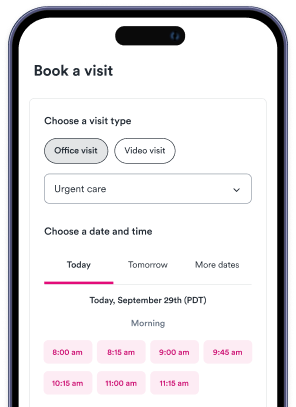Key points
- Common spring viruses include rhinovirus, influenza, RSV, human metapneumovirus, enteroviruses, and COVID-19, with symptoms often overlapping with seasonal allergies.
- Distinguishing between allergies and viral infections can be done by observing symptoms such as fever, nasal discharge color, body aches, and duration of symptoms.
- Early testing for spring viruses is crucial for appropriate treatment, protecting others, and knowing when to isolate; persistent high fever, difficulty breathing, severe sore throat, and rapid onset of symptoms are key indicators.
- Testing options include rapid flu tests, COVID-19 rapid and PCR tests, RSV testing, and viral respiratory panels, available at urgent care centers, retail clinics, and through telehealth services.

As winter fades and temperatures climb, spring welcomes not only blooming flowers but also a new wave of viral illnesses. Seasonal transitions can weaken immune defenses and create ideal conditions for respiratory viruses to spread, especially as people spend more time outdoors or gather for spring activities. From the lingering flu to lesser-known viruses like RSV and human metapneumovirus, understanding what's circulating — and knowing when and where to get tested — can help protect your family and community. Here’s what you should know about the common spring viruses of 2025 and how to stay one step ahead.
What are the most common spring viruses?
While winter is known for peak flu season, several respiratory viruses continue to circulate well into the spring months. The CDC explains that warmer weather doesn't immediately stop the spread of illnesses, especially when changing temperatures and seasonal allergies can weaken the immune system.
Understanding which viruses are most active can help you recognize symptoms early and seek the right testing or care if needed. Here are the top viruses you’re most likely to encounter this spring, according to the CDC:
- Rhinovirus (common cold): A major cause of mild respiratory symptoms like runny nose, congestion, and sore throat.
- Influenza (spring flu cases): Though flu season peaks in winter, cases often spill into spring, especially in cooler regions.
- RSV (Respiratory Syncytial Virus): Typically more serious in young children and older adults, RSV can cause cough, wheezing, and breathing difficulties.
- Human metapneumovirus: A lesser-known virus that can mimic cold or flu symptoms, often leading to bronchitis or pneumonia in some cases.
- Enteroviruses: These can cause a range of illnesses in the spring and summer, from mild cold-like symptoms to more serious conditions like viral meningitis.
- COVID-19 (still circulating in waves): Even in 2025, COVID-19 remains active with occasional localized outbreaks, particularly affecting unvaccinated or high-risk groups.
Symptoms to watch for: Spring viruses vs. allergies
During spring, it can be surprisingly tricky to tell the difference between a viral infection and seasonal allergies. Both can cause congestion, sneezing, and general fatigue, but understanding the key differences helps you know when to seek testing or medical care. Allergies are triggered by the immune system’s response to pollen and other allergens, while viruses are caused by infections that can become more serious without treatment, according to the CDC. Here’s how to tell them apart:
- Fever vs. no fever: Viruses often cause a mild to high fever, while allergies typically do not cause a fever.
- Nasal discharge color: Allergy-related nasal drainage is usually clear and watery, whereas a yellow or green discharge is more common with viral infections.
- Body aches and chills: Viruses frequently cause body aches, fatigue, and chills — symptoms not typically seen with seasonal allergies.
- Duration of symptoms: Allergy symptoms can last for weeks or even months as long as pollen levels stay high, while viral illnesses tend to run their course within 7–10 days.
When should you get tested for a spring virus?
Early testing can make a big difference when it comes to managing springtime illnesses — both for your own health and to prevent spreading viruses to others, according to the CDC. Many spring viruses cause overlapping symptoms, making it difficult to tell exactly which one you might have without a diagnostic test. Getting tested right away can help you get the right treatment, protect vulnerable people around you, and know when to stay home. Consider getting tested if you experience:
- A persistent high fever —lasting longer than 48 hours or climbing above 101°F — may indicate a viral infection that requires medical attention.
- Difficulty breathing: Shortness of breath, wheezing, or chest tightness may indicate RSV, flu, COVID-19, or another severe respiratory infection.
- Severe sore throat: If your sore throat makes it hard to swallow or worsens quickly, testing can help determine whether a virus or another condition is causing it.
- Rapid onset of symptoms: Sudden symptoms, such as chills, body aches, and cough, appearing within a day or two, suggest a viral infection.
- Contact with others who are sick: If you've recently been around someone diagnosed with a viral illness, testing can help catch infections early, even if symptoms are mild at first.
Types of tests available for spring viruses
If you’re feeling under the weather this spring, several fast and reliable testing options are available to help identify the cause of your symptoms. Many urgent care centers and clinics offer same-day testing, making it easier to confirm a diagnosis and start any needed treatment quickly. Depending on your symptoms and exposure risk, a healthcare provider may recommend one or more of the following tests:
- Rapid flu tests: Quick nasal swab tests that detect influenza A and B viruses within minutes, helping guide treatment decisions like antiviral medications.
- COVID-19 rapid and PCR tests: Rapid antigen tests provide results in as little as 15 minutes, while PCR tests offer highly accurate results within a few hours to a day.
- RSV testing: A nasal swab can confirm RSV, which is particularly important for young children, older adults, or anyone with breathing difficulties.
- Viral respiratory panels: These advanced tests check for multiple viruses at once, including flu, RSV, COVID-19, and others, using a single sample — ideal when symptoms overlap.
Where to get tested for spring viruses near you
If you or a loved one starts experiencing symptoms of a spring virus, it’s important to find a reliable testing location quickly, according to the CDC. Fortunately, there are several convenient options available in most communities. Many urgent care centers offer walk-in or same-day appointments for virus testing, providing a fast way to get answers without needing a trip to the ER.
Retail clinics located inside pharmacies and big-box stores also offer tests for flu, COVID-19, and respiratory viruses, often with extended hours on evenings and weekends. For those who prefer to stay home, telehealth services now allow you to order at-home testing kits that deliver results quickly and securely. For families with young children, pediatric urgent care clinics specialize in testing and treating common childhood illnesses, offering care specifically designed for younger patients.
Book a same-day virus test at urgent care near you
If you or a loved one is feeling under the weather, don’t wait to get the answers you need. Many urgent care centers offer same-day and next-day virus testing appointments, helping you confirm an illness and start recovery quickly. With Solv, it’s easy to find trusted urgent care clinics near you, view real-time availability, and book an appointment in just a few clicks. Get tested today — and get back to feeling better faster.
FAQs
What are some common viruses that circulate during the spring?
The most common viruses during the spring season include Rhinovirus, Influenza, Respiratory Syncytial Virus (RSV), Human metapneumovirus, Enteroviruses, and COVID-19. These viruses can cause a range of symptoms from mild cold-like symptoms to more severe conditions like viral meningitis.
How can I differentiate between a spring virus and seasonal allergies?
Viral infections and seasonal allergies can have similar symptoms like congestion, sneezing, and fatigue. However, there are key differences. Viruses often cause a fever, body aches, and chills, and symptoms usually run their course within 7–10 days. Allergies, on the other hand, do not cause a fever or body aches, and symptoms can last for weeks or even months as long as pollen levels stay high.
When should I get tested for a spring virus?
You should consider getting tested for a spring virus if you experience a persistent high fever lasting longer than 48 hours or climbing above 101°F, difficulty breathing, a severe sore throat, rapid onset of symptoms, or have been in contact with others who are sick. Early testing can help manage illnesses and prevent spreading viruses to others.
What types of tests are available for spring viruses?
There are several testing options available for spring viruses. These include Rapid flu tests, COVID-19 rapid and PCR tests, RSV testing, and Viral respiratory panels. These tests can help identify the cause of your symptoms and guide treatment decisions.
Where can I get tested for spring viruses?
You can get tested for spring viruses at many urgent care centers and clinics that offer same-day testing. Retail clinics located inside pharmacies and big-box stores also offer tests for flu, COVID-19, and respiratory viruses. Telehealth services allow you to order at-home testing kits. For families with young children, pediatric urgent care clinics specialize in testing and treating common childhood illnesses.









